Halo 4 – Singleplayer Campaign Review
by Tom
|
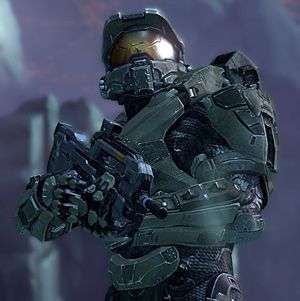 It’s been the best part of half a decade since game developers Bungie left their lead man and lady drifting in the eternal black void of space. In the years since then, fans have been treated to two games that dived into the past of the Halo universe (Halo 3: ODST and Halo Reach), but despite this most of us, if not all, were left wondering, “What has happened to the Chief?” Well, after five years, a buyout by the Microsoft Corporation and a new developer taking over the reins it was finally time for Master Chief to dust off his armour and prove to the world that Spartans never die.
It’s been the best part of half a decade since game developers Bungie left their lead man and lady drifting in the eternal black void of space. In the years since then, fans have been treated to two games that dived into the past of the Halo universe (Halo 3: ODST and Halo Reach), but despite this most of us, if not all, were left wondering, “What has happened to the Chief?” Well, after five years, a buyout by the Microsoft Corporation and a new developer taking over the reins it was finally time for Master Chief to dust off his armour and prove to the world that Spartans never die.
Developed by 343 Industries, this is the first game to continue the storyline of the Halo franchise that hasn’t been the product of the Bungie studio. So how does 343’s first Halo game fare? Honestly? Really well. Somehow, either through magic or science, they’ve managed to distil the best features of the previous games and combine them with their own fresh ideas.
Perhaps the most surprising good feature is the plot. This doesn’t mean that the plots of the previous games were bad – ODST and Reach were engrossing and Halo 3’s plot was solid, if not outstanding – Halo 4, however, takes things to the next level and sets an extremely high benchmark for all future first person shooters. Set four years after the events of Halo 3, we join Master Chief and his AI companion Cortana adrift on the wreck of the UNSC space ship ‘Forward Unto Dawn’. During their time aboard, the Chief has remained in stasis while Cortana has kept a constant vigil over him, but she is forced to wake him up when she detects intruders within the wreckage. What follows are the efforts of the pair to work their way back to earth while dealing the changes that have taken place in the years they’ve been out of action. This, however, is only the start.
There are two primary plotlines, both so well explained and written that it would be difficult to define which was intended to be the main storyline and which is the subplot. The first is introduced straight off the block: Cortana is, for want of a better term, ill. Having outlasted her predicted operating period of seven years she has begun to degrade, suffering from a symptom known as ‘rampancy’. It is explained that all AIs eventually suffer from rampancy when they reach a certain age; they lose control of their mind, with their thought processes running simultaneously until they think themselves to death. Naturally the Chief promises that he will try to help Cortana by getting her to her creator. Throughout the game Cortana suffers from attacks of rampancy as she slowly loses control, all while Master Chief tries to assure her that everything will be okay.
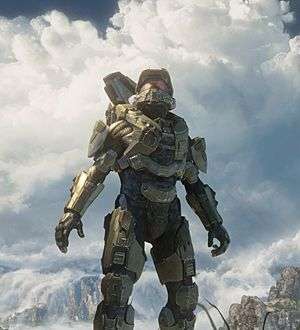 This could best be described as the ‘emotional plotline’. The characters of Master Chief and Cortana are both developed a great deal and share a number of emotional moments; they are constantly trying to reassure each other and themselves, which is understandable considering all they’ve been through together. For the first time we see that the Chief has feelings, that he is ultimately human and not a machine, and this plays a huge role throughout the game, resulting in an ending that was powerful and dramatic. The other plotline is more of the typical good guy/bad guy scenario. A hostile race is encountered and threatens to destroy you and everything you stand for. While this follows the more traditional path of an FPS story, the execution is something else entirely. With intense cut-scenes and some startling realisations, every progression in the story makes the situation worse and worse, leaving you wondering just how can the odds be overcome. The plotline also offers a great deal of insight into the history of the Halo universe (which if, like me, you haven’t read any of the novels is eye-opening to say the least).
This could best be described as the ‘emotional plotline’. The characters of Master Chief and Cortana are both developed a great deal and share a number of emotional moments; they are constantly trying to reassure each other and themselves, which is understandable considering all they’ve been through together. For the first time we see that the Chief has feelings, that he is ultimately human and not a machine, and this plays a huge role throughout the game, resulting in an ending that was powerful and dramatic. The other plotline is more of the typical good guy/bad guy scenario. A hostile race is encountered and threatens to destroy you and everything you stand for. While this follows the more traditional path of an FPS story, the execution is something else entirely. With intense cut-scenes and some startling realisations, every progression in the story makes the situation worse and worse, leaving you wondering just how can the odds be overcome. The plotline also offers a great deal of insight into the history of the Halo universe (which if, like me, you haven’t read any of the novels is eye-opening to say the least).
These gripping and immersive storylines are not just down to superb scriptwriting, but a myriad of reasons: the high quality of the voice acting gives weight to every word the characters utter, the awesome graphics put real emotion into their faces (except for the Chief, but in this case the voice acting becomes truly effective), and the sheer imaginative scope the writers must possess to deliver such an ambitious idea. The only real flaw to the story is the length, providing around six hours of gameplay on normal difficulty. Inevitably this time will increase on higher difficulties, though mostly due to dying and respawning. 343 have clearly placed quality over quantity and I personally feel it was the best choice to make, leaving you wanting more sooner, rather than leaving you disappointed.
 |
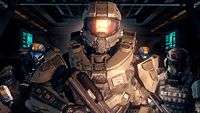 |
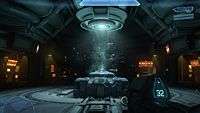 |
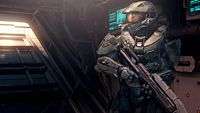 |
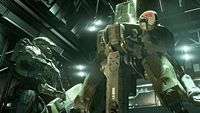 |
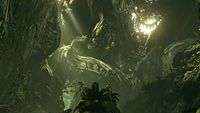 |
It isn’t just the story that has impact, however. Whichever way you choose to look at it Halo 4 is a stunningly attractive game, both in design and graphic quality. In the intro video we are treated to everything the graphic engine has to offer in what can only be described as one of the most visually impressive animation sequences I’ve seen in a videogame. During the video the creator of the Spartans, Dr Catherine Halsey, is being interrogated and it genuinely took a second glance to realise that she was, in fact, animated. Her body movement, facial expressions and the level of detail visible in her design blows games that claim to have ‘superior’ facial design clean out of the water (looking at you, LA Noire).
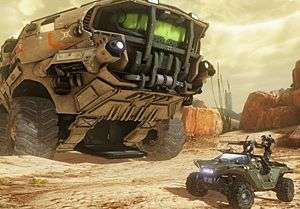 Though the graphic engine saves its best work for the cutscenes, the in-game graphics are still outstanding, presenting the player with a visual experience that is an absolute joy. Graphically it has come on in leaps and bounds from its predecessors, adopting an edgier, crisper feel. Everything transferred from the previous games has received a thorough redesign, maintaining the original features but improving them to fit seamlessly with the newer style. For instance, the iconic Halo assault rifle (shown in most of the franchise’s advertising material) has been spruced up and now wouldn’t look out of place in the real world (not to mention that it now sounds and recoils like a real assault rifle should).
Though the graphic engine saves its best work for the cutscenes, the in-game graphics are still outstanding, presenting the player with a visual experience that is an absolute joy. Graphically it has come on in leaps and bounds from its predecessors, adopting an edgier, crisper feel. Everything transferred from the previous games has received a thorough redesign, maintaining the original features but improving them to fit seamlessly with the newer style. For instance, the iconic Halo assault rifle (shown in most of the franchise’s advertising material) has been spruced up and now wouldn’t look out of place in the real world (not to mention that it now sounds and recoils like a real assault rifle should).
The newer designs are very unique, in particular the new enemy type known as the ‘Prometheans’. With mostly white armour and glowing orange lights they have a clean futuristic look (imagine Apple designed soldiers) that makes them stand out from the usually dark coloured or camouflaged enemies of most other games. The Prometheans come equipped with matching guns which, when lying on the ground, appear disassembled; when they are picked up the pieces reconstruct. The guns themselves mostly serve as modified versions of existing weapons, but with some altered stats (e.g. higher damage output or increased clip capacity). The matching designs of both the guns and those wielding them helps to create a strong sense of identity for this new race. Credit is certainly warranted for the way designs either compliment or contrast with each other, which brings me round to the environments.
Halo 4 offers a huge range of different terrains, from the awe-inspiring grandeur of the Forerunner architecture to the lush, verdant jungles. They are used to achieve the absolute best effect possible, with a clear goal and intention in mind. For example, when the Prometheans are first encountered you are stranded in an arid desert location; the colour pallet is muted and the more interesting terrain features are kept in the distance, allowing the bold forms and simple colouring of the enemy to be easily seen, letting you fully appreciate them. However, later in the game, during a section in a jungle, they are much harder to spot as they hide in wait amongst the deep greens and brighter foliage. Not only does this look great but it also impacts on the manner in which you play. Whereas before when they could be seen clearly in the desert, giving you the advantage, now a more cautious approach has be taken to ensure your journey isn’t abruptly ended by a sneaky Jackal hiding in the wings with a carbine.
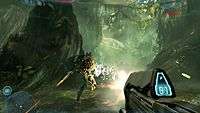 |
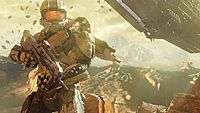 |
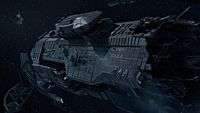 |
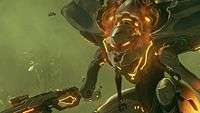 |
 |
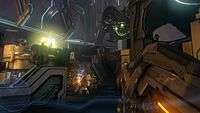 |
Yes, that’s right, a Jackal. The Covenant are back and have returned to their human-fighting ways. Aside from a few aesthetic tweaks they haven’t really changed too much. Grunts, Jackals, Elites and Hunters all make a comeback (Drones and Brutes are curiously absent), and with their return they bring their usual assortment of vehicles as well as an expanded array of weaponry. As for the game’s other enemy set, the Prometheans, they come in three varieties: Knights, Crawlers, and Watchers. Knights aren’t dissimilar to the Elites or Brutes with regards to their strength and combat skill, but they have the added ability to teleport and spawn Watchers. The Watchers seem to have replaced the Drones; they fly around the battlefield providing support to the other Promethean units in the form of shields, as well as firing at you (not to mention catching your grenades and hurling them back at you). Lastly, the Crawlers are dog-like foes, which fire lasers from a set of mandible-esque jaws, and are fast on their feet – they can easily flank you while you focus on a Knight or blowing Watchers out the sky.
The fluid movement capabilities of the Prometheans makes them completely different to fight from the Covenant forces. While Knights pose an obvious threat as the heavy hitters, Crawlers will often attempt to swarm you, dropping your shields with repeated volleys of fire and leaving you exposed to stronger units, meaning that you need to stay aware of what’s happening around you.
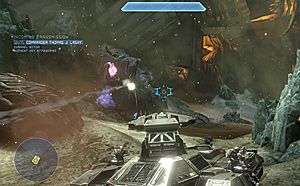 With this in mind, it’s fair to say that now, more than ever, tactics and forward planning are essential. Encounters with hostiles actually requires some thought, rather than simply bum-rushing them. If you rush the Knight will the Watcher he’s spawned drop your shields and leave you open to a kill shot? In addition, the difficultly level seems to have been stepped up (not considerably, but it’s definitely noticeable), meaning that the likelihood of a valiant charge will ultimately lead to you being ripped apart by plasma fire or having a particularly nasty enemy cave your face in with the butt of his gun.
With this in mind, it’s fair to say that now, more than ever, tactics and forward planning are essential. Encounters with hostiles actually requires some thought, rather than simply bum-rushing them. If you rush the Knight will the Watcher he’s spawned drop your shields and leave you open to a kill shot? In addition, the difficultly level seems to have been stepped up (not considerably, but it’s definitely noticeable), meaning that the likelihood of a valiant charge will ultimately lead to you being ripped apart by plasma fire or having a particularly nasty enemy cave your face in with the butt of his gun.
It is also worth pointing out that the enemy AI isn’t infallible, and is occasionally prone to what I can only describe as mental breakdowns. One such instance was the Elite pilot who decided to grind the front of his Banshee across the ground until I got bored of watching and shot him. Despite being a flaw these moments do provide intermittent hilarity, which goes some way to making up for it.
Halo 4′s new additions more than make up for a not-so-flawless AI, and, for me, there are two that stand out – two new usable vehicles: the Mantis and the Pelican. This is the first time the Pelican has been pilotable, and as an extra treat it comes fitted with a chaingun and a Spartan laser. The Mantis is a 20ft tall mechanical suit fitted with shields, a machinegun on one arm and a rocket pod on the other. Vehicles aside, there is what has become one of my favourite sequences – an ‘Ace Combat’ style mission where the Chief must fly a Broadsword (an updated version of the Sabre from Halo Reach) through a metal gorge bristling with moving obstacles and enemy gun positions. Somewhat similar to a mission from Halo Reach (Long Night of Solace), this mission provides a nice change of pace from the standard FPS format and the mechanics work very well, which can mostly be attributed to the fact that they have been kept as simple as possible.
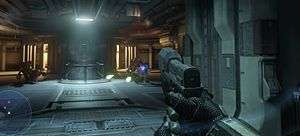 Combat utilises the same control layout already established in the Halo series, allowing players of previous titles to simply slip into them like an old familiar glove. One of the better features to be retained from the older set ups are the stealth kills – short (and often brutal) quick time events triggered when the Chief melees a target from behind. Several different QTEs exist for each enemy type, providing some nice variety.
Combat utilises the same control layout already established in the Halo series, allowing players of previous titles to simply slip into them like an old familiar glove. One of the better features to be retained from the older set ups are the stealth kills – short (and often brutal) quick time events triggered when the Chief melees a target from behind. Several different QTEs exist for each enemy type, providing some nice variety.
Halo 4 has a truly epic feel. An exceedingly well-crafted storyline is strengthened by mind-blowing visuals, natural voice acting, a simple and effective combat system and a soundtrack that, while not memorable, compliments the events, leaving the player able to absorb what’s happening. This was the game that Halo 3 had promised to be before it was utterly let down by the hype. It serves as an example that sometimes change can be the best thing for a franchise and I for one wonder where the Halo series would be now if 343 had taken over before the creation of Halo 3. Intended to be the first in a new Halo trilogy named the ‘Reclaimer Trilogy’, I can’t wait to see 343’s next offering – I just pray that they can continue to hit the high benchmark they have set.
Pros- Awesome graphics and designs
- Superb voice acting
- Reliable and easy to use mechanics
- Epic storyline
- Great atmosphere
- AI occasionally lets itself down
- A little too short
- Somewhat expensive if you don’t intend to play multiplayer
Halo 4 does the franchise proud. Although the campaign might be short it offers an experience that other FPSs can’t match. The development of the Halo storyline is handled fantastically, propelling the universe forward into the new trilogy with an engaging and imaginative campaign.
Graphically it is one of the best games currently on release, with an original artistic style, and the voice acting is both natural and immersive. If you enjoy the full Halo game experience, both the campaign and multiplayer, then I recommend picking it up. If, like me, you aren’t into multiplayer then wait a little while for the price to drop, but it is worth playing. For me this has set the bar for FPS games and I hope it starts a trend for more immersive shooters.
Last five articles by Tom
- Why I Hate Mario
- Best of 2013: Virtually Reality
- Best of 2013: Move, Bitch! Get Out Of The Way!
- Virtually Reality
- Soundtrack Synopsis

















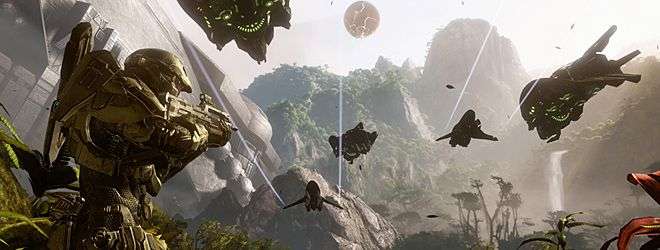
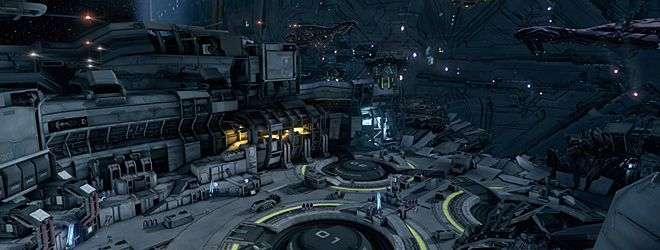
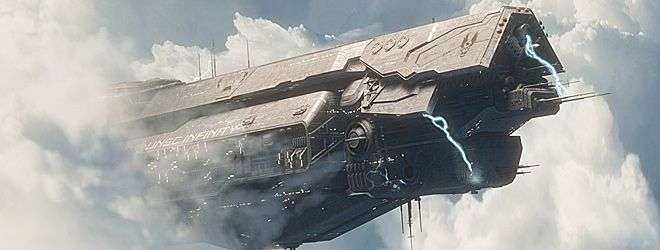






The only FPS I play. Was dubious when 343 got the legacy, but they seem to have caught the Halo spirit and given it a slightly different perspective, which is nice.
Interesting to read such an in-depth analysis of the campaign – most reviews wax on about Multiplayer, but this is a great, detailed review.
It looks stunning.